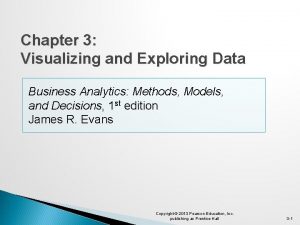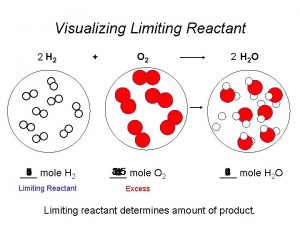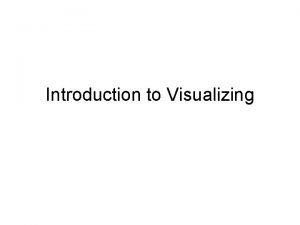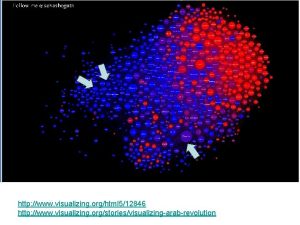VISUALIZING YOUR DATA EFFECTIVELY Kim Unger Fall 2017


















- Slides: 18

VISUALIZING YOUR DATA EFFECTIVELY Kim Unger – Fall 2017

ABOUT ME Senior Analytics Consultant, Data. Brains Former SSEF, ISEF, STS Finalist Science Fair Judge (regional, SSEF, ISEF) Data Visualization is my day-to-day job kunger@databrains. com @Wizard. Of. Viz

AGENDA Overview – four questions Choosing the right chart/graph Other visualizations Visual Best Practice Tableau – Visualization software FRE E

FOUR QUESTIONS 1. What data is important to show? 2. What do I want to emphasize in the data? 3. What options do I have for displaying this data? 4. Which option is most effective in communicating the data?


Time Series Ranking Distributio n Part-To. Whole Correlatio n Deviation Comparis on WHAT DO YOU WANT TO SHOW WITH YOUR DATA?

TIME SERIES VALUES DISPLAY HOW SOMETHING CHANGED OVER TIME Strip Plot (multiple) Bar Graph (vertical) To feature individual values and support their comparisons. Quantitative scale must begin at zero. Line Graph To feature overall trends and patterns and support their comparisons Dot Plot (vertical) When you do not have a value for every interval of time Only when also featuring distributions Box Plot (vertical)

RANKING VALUES ARE ORDERED BY SIZE (DESCENDING OR ASCENDING) Bar Graphs Quantitative scale must begin at zero Dot Plots

PART-TO-WHOLE VALUES REPRESENT PARTS (RATIOS) OF A WHOLE Bar Graphs Quantitative scale must begin at zero

WHAT ABOUT PIE CHARTS? Commonly used to show parts of a whole However… Ø Hard to judge relative size of pie slices – better at differentiating length Ø Take up a lot of space to present little information ØRequire labels and good color contrast to even be usable (often difficult) Best use is when one overwhelmingly larger value than the rest – no need to focus on actual values

DEVIATION DIFFERENCE BETWEEN TWO SETS OF VALUES Bar Graphs Quantitative scale must being at zero Line Graph Only when also featuring time series or single distribution

DISTRIBUTION COUNT OF VALUES PER INTERVAL ALONG QUANTITATIVE SCALE Bar Graphs Quantitative Scale, must begin at zero Line Graph To feature overall shape of distribution Strip Plot (single) When you want to see each value Strip Plot (multiple) When comparing multiple distributions AND you want to see each value Box Plots When Comparing Multiple Distributions

CORRELATION COMPARISON OF TWO PAIRED SETS OF VALUES TO DETERMINE IF THERE IS A RELATIONSHIP BETWEEN THEM Scatter Plot

NORMAL COMPARISON SIMPLE COMPARISON OF VALUES FOR A SET OF ORDERED ITEMS Bar Graphs Quantitative scale must begin at zero Dot Plots

Schematics Illustrations Flow Charts Raw data or statistical summaries in wellorganized manner. Convey important details. Photographs Explain how experiment was conducted or design concepts for engineering project Tables Great to show experimental setup, or examples of actual results OTHER VISUALIZ ATIONS A PICTURE IS WORTH A THOUSAND WORDS

ADHERE TO DATA PRESENTATION STANDARDS IN YOUR FIELD Judged by those often familiar with research field Expected presentations of data in that field Review scientific articles – how is data presented? Ø Ø Ø Are there graphs? What kind? What statistics are used? Review schematics – are there specific icons? Does the journal have a style guide?

Emphasize • most important data VISUAL BEST PRACTIC ES Orient • graphs for legibility Organize • graph/table Avoid • overloading graphs Limit • # of colors and shapes • Inform through important text

DATA ANALYSIS VS DATA VISUALIZATION Traditionally enter data into spreadsheet (Excel) Satisfactory, but strengths are in data analysis – not visualization Time consuming to create graph variations Alternative: Use data visualization software FREE to students and teachers with. edu email https: //www. tableau. com/academic/teaching
 Performance lawn equipment case study
Performance lawn equipment case study Analyzing and visualizing data with microsoft power bi
Analyzing and visualizing data with microsoft power bi Dr anthony unger
Dr anthony unger Randy unger
Randy unger Michael unger md
Michael unger md Timo unger
Timo unger Seminarraum weimar
Seminarraum weimar Rx cross table
Rx cross table Ron unger lcsw
Ron unger lcsw Dr anthony unger
Dr anthony unger Aed kinderreanimation
Aed kinderreanimation Unger sabine
Unger sabine Dr anthony unger sibley hospital
Dr anthony unger sibley hospital Bipolar spiritual gift
Bipolar spiritual gift Kim ki duk spring summer fall winter
Kim ki duk spring summer fall winter Njdv
Njdv Visualizing reading strategy
Visualizing reading strategy What is a limiting reactant
What is a limiting reactant Visualizing japanese grammar
Visualizing japanese grammar































